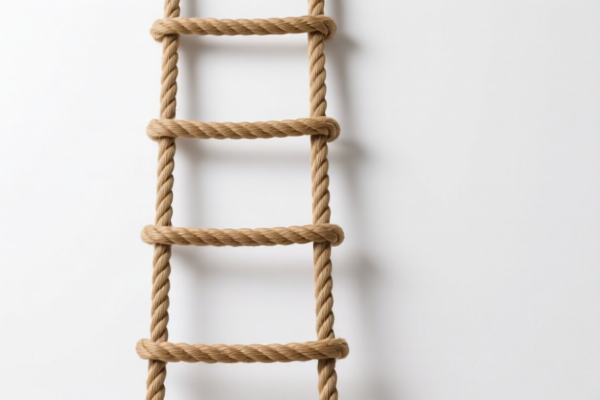| HS Code | Official Doc | Tariff Rate | Origin | Destination | Effective Date |
|---|---|---|---|---|---|
| 8307103000 | Doc | 58.8% | CN | US | 2025-05-12 |
| 8307106000 | Doc | 58.8% | CN | US | 2025-05-12 |
| 8308909000 | Doc | 57.7% | CN | US | 2025-05-12 |
| 6305900000 | Doc | 43.7% | CN | US | 2025-05-12 |
| 6305390000 | Doc | 45.9% | CN | US | 2025-05-12 |
| 6310101000 | Doc | 37.5% | CN | US | 2025-05-12 |
| 6310102010 | Doc | 37.5% | CN | US | 2025-05-12 |
| 4201006000 | Doc | 57.8% | CN | US | 2025-05-12 |
| 4205000500 | Doc | 57.9% | CN | US | 2025-05-12 |
| 4205000500 | Doc | 57.9% | CN | US | 2025-05-12 |




Rope Ladder
A rope ladder is a type of ladder constructed from two vertical ropes connected by rungs. It is a lightweight and flexible ladder often used in situations where a more rigid ladder is impractical or unavailable.
Material
Historically, rope ladders were constructed from natural fiber ropes like manila, hemp, or sisal. Modern rope ladders frequently utilize synthetic materials such as nylon, polyester, or polypropylene for increased strength, durability, and resistance to rot and mildew. Rungs are commonly made of wood, plastic, or metal (typically aluminum or steel).
Purpose
The primary purpose of a rope ladder is to provide a means of ascending or descending a vertical or near-vertical structure. They are valued for their portability and ease of deployment.
Function
Rope ladders function by distributing the user’s weight across the two vertical ropes and the rungs. The user grips the ropes and steps on the rungs to climb. The flexibility of the rope allows the ladder to conform to uneven surfaces or obstacles.
Usage Scenarios
- Emergency Escape: Commonly found on ships, aircraft, and in buildings as a rapid escape route.
- Climbing/Recreational: Used in climbing gyms, adventure courses, and by climbers for ascending cliffs or rock formations.
- Military/Rescue: Employed by military personnel and rescue teams for scaling walls, cliffs, or accessing difficult-to-reach areas.
- Playgrounds/Obstacle Courses: A common feature in children’s playgrounds and outdoor obstacle courses.
- Tree Climbing: Used for accessing treehouses or performing tree maintenance.
Common Types
- Fixed Rope Ladder: Permanently attached to a structure, often with a locking mechanism for security.
- Portable Rope Ladder: Designed for easy transport and deployment, often featuring hooks or carabiners for attachment.
- Ship’s Ladder: A specific type of rope ladder used on ships, characterized by wider, flat rungs for increased foot support.
- Adjustable Rope Ladder: Allows the user to adjust the spacing between rungs to suit different heights or climbing needs.
- Swivel Hook Rope Ladder: Features swivel hooks for easy attachment to various anchor points.
Based on the provided information, the following HS codes may be relevant to “rope ladder”:
- 6310101000: Used or new rags, scrap twine, cordage, rope and cables, and worn out articles of twine, cordage, rope or cables, of textile materials: Sorted: Of wool or fine animal hair. This code covers sorted used or new ropes made of wool or fine animal hair.
- 6310102010: Used or new rags, scrap twine, cordage, rope and cables, and worn out articles of twine, cordage, rope or cables, of textile materials: Sorted: Other Of cotton. This code covers sorted used or new ropes made of cotton.
- 8307103000: Flexible tubing of base metal, with or without fittings: Of iron or steel: With fittings. While primarily for tubing, if the rope ladder incorporates metal components as fittings, this code may be applicable.
- 8307106000: Flexible tubing of base metal, with or without fittings: Of iron or steel: Other. Similar to 8307103000, this applies if the rope ladder uses iron or steel, but without fittings.
Explanation of HS Code Structure (based on provided reference):
The HS code is a six-digit code used to classify traded products. Here's a breakdown based on the examples provided:
- Chapter (First two digits): Indicates the broad category of the product. For example, "63" signifies products related to textile materials, and "83" indicates base metal articles.
- Heading (Next two digits): Further specifies the product within the chapter. For example, "10" within Chapter 63 refers to used or new rags, scrap twine, cordage, rope and cables.
- Subheading (Last two digits): Provides even more detail about the product. For example, "1000" and "102010" further specify the type of material the rope is made of (wool or cotton).
Important Note:
The applicability of these codes depends on the specific composition and construction of the rope ladder. If the ladder incorporates metal components, both codes from Chapter 83 and Chapter 63 might be relevant. Please verify the material composition to ensure accurate classification.
Customer Reviews
No reviews yet.